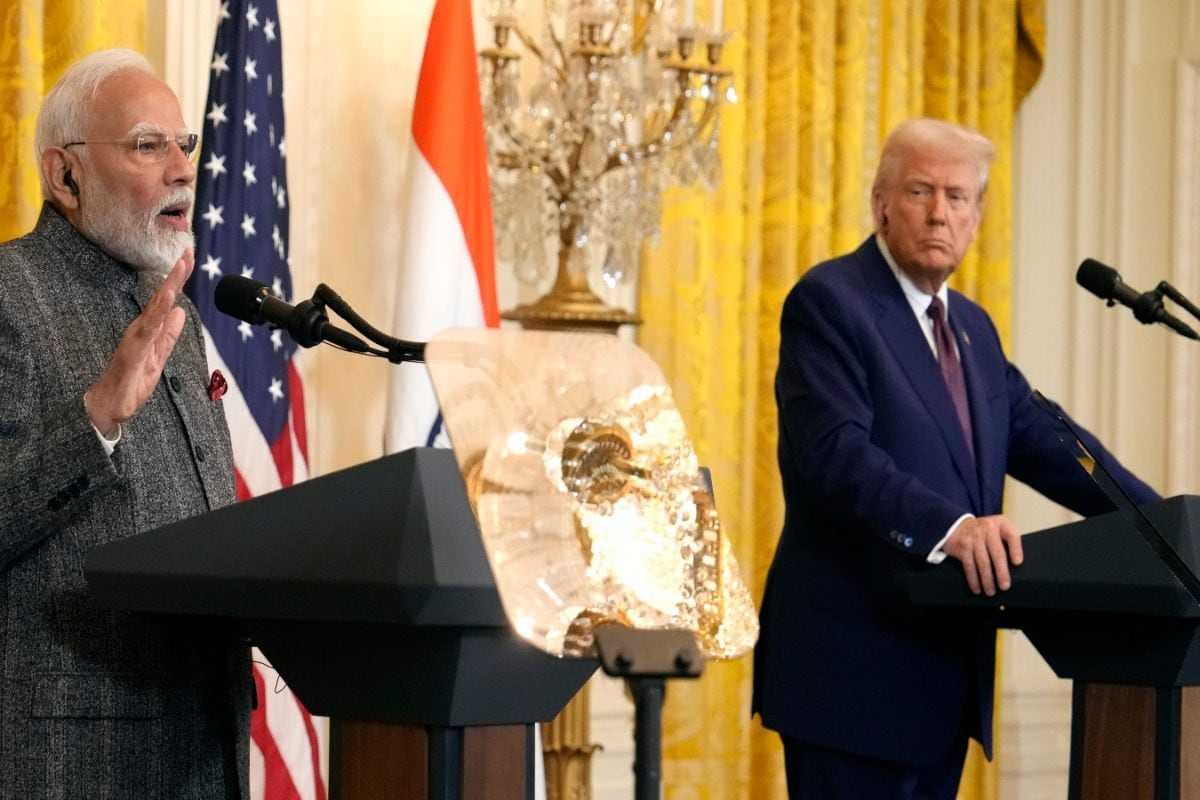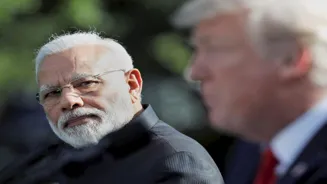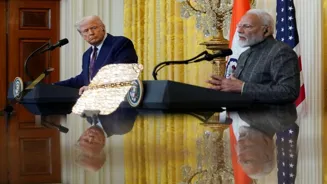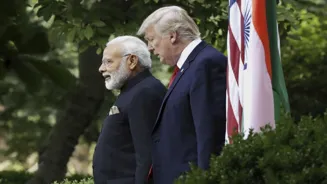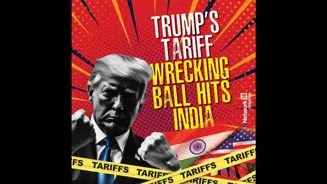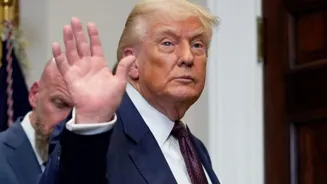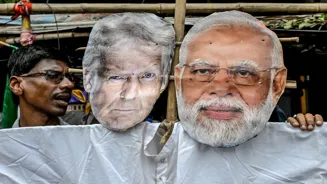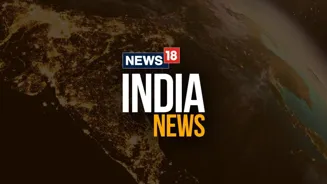“You can neither fathom Donald Trump nor can you ignore POTUS.” The man’s a walking paradox, a tangerine-tinted showman who’s slapped India with an arbitrary 50 per cent tariff hike for buying Russian
oil. It’s not policy—it’s a tantrum dressed up as tariffs but ostensibly are sanctions. Welcome to the new Great America, where whimsical decrees threaten to unravel global trade faster than a Delhi traffic jam. Let’s unpack this circus.
It is pernicious to use Donald and diplomacy in the same breath these days. Trump’s latest stunt, blasted on Truth Social on July 31, 2025, targets Bharat’s exports—diamonds, soybeans, textiles, agriculture, dairy, and nuts—with a tariff that feels like a personal vendetta. Why? Because we’re buying Russian oil, apparently a graver sin than the EU, China, or even the US doing the same. The hypocrisy’s thicker than a monsoon fog.
As per the International Energy Agency, China imported over two million barrels of Russian crude daily in 2024, outpacing India’s 1.75 million. The EU shelled out €22 billion for Russian fossil fuels, and the US quietly imported $3.5 billion in Russian goods. Yet, Bharat’s the punching bag? Classic Trump—swinging at the softer target while winking at the bigger dogs. This isn’t principle; it’s politics.
Trump’s MAGA campaign, once a shimmering beacon, is now a faded bumper sticker. His disenchanted base—heartland folks who bought the “bring back manufacturing” dream—is restless. So, he picks a fight with India to look tough. The problem is, the US isn’t spinning out diamonds, soybeans, or affordable apparel to replace our exports. The Global Trade Research Initiative says these tariffs could halve India’s $86 billion in US exports, but American consumers will be at the receiving end of this deal. Shoe prices could spike 40 per cent, apparel 38 per cent, and cars $5,800, as per the Budget Lab. Trump’s own supporters, already squeezed by inflation, will be fuming at Walmart. Nice one, Don!
Then there’s India’s agro-economy, a juggernaut with 700 million people tied to it, directly or indirectly. Agriculture—spanning dairy, blue, and green sectors—contributes almost 25 per cent to our GDP. Our dairy sector alone, valued at $140 billion, dwarfs the US’s paltry $120 million. Trump’s been itching for unhinged, unfettered access to this market, but Prime Minister Narendra Modi has slammed the door shut, prioritising India’s farmers over American businessmen. This snub’s a sore spot for Trump, who’s used to bullying his way into markets. Add to that the irony of I.N.D.I. Alliance parties—vocal critics of domestic agricultural privatisation—suddenly cheering for globalisation (read: international privatisation) when it suits their anti-Modi narrative. They want to show their solidarity in regional ambitions, but not for national aspirations, and this duplicity is out in the open.
And that Russian oil obsession? Trump’s framing India as Putin’s sidekick, conveniently forgetting the US nudged us to buy Russian crude early in the Ukraine war to stabilize energy prices, is, well, ignominy at its peak. Now he’s flipped, crying foul while ignoring China’s massive imports and the EU’s LNG addiction. It’s selective outrage, pure and simple. “The United States is happy for India to continue buying as much Russian oil as it wants, including at prices above a G7-imposed price cap mechanism, if it steers clear of Western insurance, finance, and maritime services bound by the cap,” remarked former Treasury Secretary Janet Yellen in November 2022. US Ambassador Eric Garcetti, who once remarked publicly that India buying Russian oil keeps markets steady, must be wondering what game he’s playing. Nikki Haley perhaps raised an alarm when she commented, “Don’t give China a pass and burn a relationship with a strong ally like India.” But perhaps in vain.
Then there’s India’s service sector, a $131.8 billion trade juggernaut in 2024-25. IT, telecom, and pharma—our big guns—escape Trump’s tariffs unscathed. How convenient! It’s like he’s sparing the sectors American corporations lean on while hammering our MSMEs in textiles and gems. The US congressman Gregory Meeks slammed Trump, saying, X: “Trump’s latest tariff tantrum risks years of careful work to build a stronger US-India partnership. We have deep strategic, economic, and people-to-people ties. Concerns should be addressed in a mutually respectful way consistent with our democratic values.” Yet, here we are, with Trump caught with his hands in the pickle, tossing diplomacy out the window.
Trump’s tariffs aren’t just a jab at India—they might herald the harakiri of the WTO and globalisation, in toto. The average US tariff rate hit 18.3 per cent by August 2025, a century-high. This isn’t policy; it’s a cataclysmic tremor to the world order that kept trade humming. Ajay Srivastava of the Global Trade Research Initiative notes that targeting India pushes us toward Russia and China, straining the Quad alliance.
Let’s not forget America’s favourite hustle, no matter whomsoever plays POTUS: playing glorified arms dealer. Trump gripes about India’s Russian weapons buys but stays mum on the US pushing F-35s and MQ-9B drones on us. Meanwhile, Pakistan’s Field (read failed) Marshal, Asif Munir, has waltzed into the White House twice in the past two months, cosying up to Trump’s crew. Terrorists and arms dealers somehow make for strange bedfellows, don’t they? The US has always been an international bully, dressing self-interest as moral crusades.
So, what’s India’s play? In the short term, these tariffs will bruise our MSMEs—textile, leather, and jewellery exporters are already reeling. The government must step up, either with subsidies to soften the blow or by brokering FDI and venture capital to back our exporters, guaranteeing loans for 12 months until the dust settles. Long term, we need a 2030 deadline to double manufacturing in textiles, gems, and agro-products via Make in India, cutting reliance on the US market.
Our dairy sector’s strength—$140 billion and growing—gives us leverage to pivot to new markets, not bow to Trump’s whims. Not that we have a dearth of options. The policymakers need to sit down with stakeholders and mull upon a consensus on realignment and recalibration of our operations.
Our 2025 Free Trade Agreement with Britain will offset losses by opening markets for apparel, spices, and dairy. Deepening ties with US allies like Japan, Australia, and the EU—through deals like the India-EU FTA—can compel a brooding, if not kindling, sense of remorse in the US. If we play it smart, we can turn Trump’s tantrum into an opportunity, sidelining America while strengthening strategic partnerships. The US might be the biggest market, but it’s not the only one. Our agro-economy, with 700 million stakeholders, isn’t some bargaining chip for Trump’s MAGA melodrama. Modi’s refusal to open the sector shows we’re playing the long game, not dancing to a flippant POTUS’s tune.
Trump’s tariffs are less about India and more about a flailing showman chasing lost MAGA glory. He’s betting on bluster, but he’s miscalculated. These sanctions will hike prices for Americans, alienate allies, and push Bharat toward new horizons. As Rahul Gandhi put it, Trump’s a “bully,” but we know India’s tougher than that. Our farmers, our MSMEs, our 1.4 billion-strong spirit—we’ll outsmart the chaos and come out stronger. Welcome to your Great America, Don—hope you’re ready for the blowback.
Yuvraj Pokharna is an independent journalist and columnist. He tweets with @iyuvrajpokharna. Views expressed in the above piece are personal and solely those of the author. They do not necessarily reflect News18’s views.
